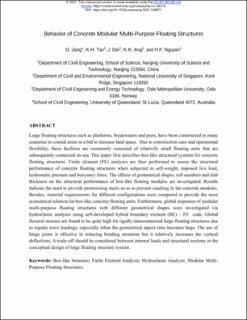| dc.contributor.author | Jiang, Dongqi | |
| dc.contributor.author | Tan, Kiang Hwee | |
| dc.contributor.author | Dai, Jian | |
| dc.contributor.author | Ang, Kok Keng | |
| dc.contributor.author | Nguyen, Huu Phu | |
| dc.date.accessioned | 2021-09-24T15:36:06Z | |
| dc.date.available | 2021-09-24T15:36:06Z | |
| dc.date.created | 2021-04-24T09:39:09Z | |
| dc.date.issued | 2021-04-21 | |
| dc.identifier.issn | 0029-8018 | |
| dc.identifier.uri | https://hdl.handle.net/11250/2781474 | |
| dc.description.abstract | Large floating structures such as platforms, breakwaters and piers, have been constructed in many countries in coastal areas in a bid to increase land space. Due to construction ease and operational flexibility, these facilities are commonly consisted of relatively small floating units that are subsequently connected on sea. This paper first describes box-like structural systems for concrete floating structures. Finite element (FE) analyses are then performed to assess the structural performance of concrete floating structures when subjected to self-weight, imposed live load, hydrostatic pressure and buoyancy force. The effects of geometrical shapes, cell numbers and slab thickness on the structural performance of box-like floating modules are investigated. Results indicate the need to provide prestressing steels so as to prevent cracking in the concrete modules. Besides, material requirements for different configurations were compared to provide the most economical solution for box-like concrete floating units. Furthermore, global responses of modular multi-purpose floating structures with different geometrical shapes were investigated via hydroelastic analyses using self-developed hybrid boundary element (BE) – FE code. Global flexural stresses are found to be quite high for rigidly-interconnected large floating structures due to regular wave loadings, especially when the geometrical aspect ratio becomes large. The use of hinge joints is effective in reducing bending moments but it relatively increases the vertical deflections. A trade-off should be considered between internal loads and structural motions in the conceptual design of large floating structure system. | en_US |
| dc.description.sponsorship | Funding supports has come from the Natural Science Foundation of Jiangsu Province under Grant No. BK20180487 and the National Natural Science Foundation of China (NSFC) under Grant No.51808292 | en_US |
| dc.language.iso | eng | en_US |
| dc.publisher | Elsevier | en_US |
| dc.relation.ispartofseries | Ocean Engineering;Volume 229, 1 June 2021, 108971 | |
| dc.rights | Attribution-NonCommercial-NoDerivatives 4.0 Internasjonal | * |
| dc.rights.uri | http://creativecommons.org/licenses/by-nc-nd/4.0/deed.no | * |
| dc.subject | Box-like structures | en_US |
| dc.subject | Finite element analyses | en_US |
| dc.subject | Hydroelastic analyses | en_US |
| dc.subject | Modular multi-purpose floating structures | en_US |
| dc.title | Behavior of concrete modular multi-purpose floating structures | en_US |
| dc.type | Peer reviewed | en_US |
| dc.type | Journal article | en_US |
| dc.description.version | acceptedVersion | en_US |
| dc.rights.holder | © 2021 Elsevier | en_US |
| dc.source.articlenumber | 108971 | en_US |
| cristin.ispublished | true | |
| cristin.fulltext | postprint | |
| cristin.fulltext | postprint | |
| cristin.qualitycode | 1 | |
| dc.identifier.doi | https://doi.org/10.1016/j.oceaneng.2021.108971 | |
| dc.identifier.cristin | 1906120 | |
| dc.source.journal | Ocean Engineering | en_US |
| dc.source.volume | 229 | en_US |
| dc.relation.project | Natural Science Foundation of Jiangsu Province: BK20180487 | en_US |
| dc.relation.project | National Natural Science Foundation of China: 51808292 | en_US |

